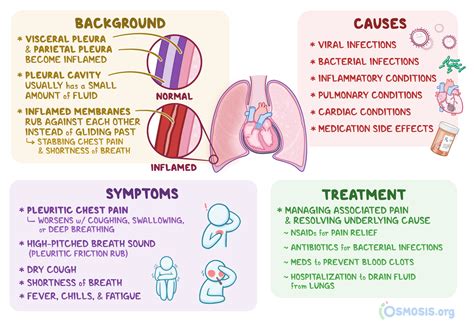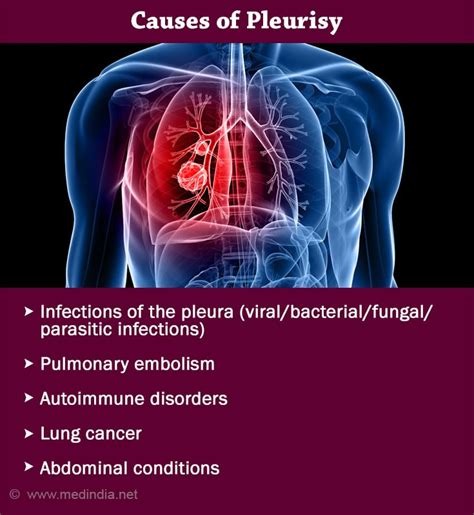Intro
Learn about pleuritic chest discomfort causes, symptoms, and treatments. Understand sharp chest pain, breathing difficulties, and related respiratory issues like pneumonia and pleurisy.
Pleuritic chest discomfort is a type of chest pain that occurs when the pleura, a two-layered membrane surrounding the lungs, becomes inflamed or irritated. This condition can be caused by a variety of factors, including viral or bacterial infections, pulmonary embolism, and pneumothorax. The pain associated with pleuritic chest discomfort is often sharp and stabbing, and can worsen with deep breathing, coughing, or movement. It is essential to seek medical attention if you experience any symptoms of pleuritic chest discomfort, as it can be a sign of an underlying serious condition.
The importance of understanding pleuritic chest discomfort lies in its potential to be a symptom of a life-threatening condition. For instance, pulmonary embolism, which is a blockage of an artery in the lungs, can cause pleuritic chest discomfort. If left untreated, pulmonary embolism can lead to serious complications, including death. Therefore, it is crucial to be aware of the signs and symptoms of pleuritic chest discomfort and to seek medical attention immediately if you experience any unusual chest pain.
Pleuritic chest discomfort can be a challenging condition to diagnose, as its symptoms can be similar to those of other conditions, such as myocardial infarction or pneumonia. However, with the help of imaging tests, such as chest X-rays and computed tomography (CT) scans, and laboratory tests, such as blood tests and pulmonary function tests, healthcare professionals can accurately diagnose and treat the underlying cause of pleuritic chest discomfort. In this article, we will delve into the world of pleuritic chest discomfort, exploring its causes, symptoms, diagnosis, and treatment options, as well as providing tips on how to manage and prevent this condition.
What is Pleuritic Chest Discomfort?

Causes of Pleuritic Chest Discomfort
The causes of pleuritic chest discomfort can be divided into several categories, including infectious, non-infectious, and traumatic causes. Some of the most common causes of pleuritic chest discomfort include: * Viral or bacterial infections, such as pneumonia or tuberculosis * Pulmonary embolism, which is a blockage of an artery in the lungs * Pneumothorax, which is a collapse of the lung due to air or gas in the pleural space * Pleurisy, which is an inflammation of the pleura * Lung cancer, which can cause pleuritic chest discomfort due to the growth of cancer cells in the lungs or pleuraSymptoms of Pleuritic Chest Discomfort

Diagnosis of Pleuritic Chest Discomfort
The diagnosis of pleuritic chest discomfort typically involves a combination of physical examination, medical history, and diagnostic tests. Some of the diagnostic tests that may be used to diagnose pleuritic chest discomfort include: * Chest X-rays, which can help to identify any abnormalities in the lungs or pleura * Computed tomography (CT) scans, which can provide more detailed images of the lungs and pleura * Pulmonary function tests, which can help to assess lung function and identify any abnormalities * Blood tests, which can help to identify any underlying infections or conditions * Thoracentesis, which is a procedure that involves removing fluid from the pleural space for analysisTreatment Options for Pleuritic Chest Discomfort

Prevention and Management of Pleuritic Chest Discomfort
There are several steps that can be taken to prevent and manage pleuritic chest discomfort, including: * Practicing good hygiene, such as washing hands regularly, to reduce the risk of infection * Avoiding smoking and secondhand smoke, which can increase the risk of lung disease * Getting vaccinated against flu and pneumonia, which can help to reduce the risk of infection * Managing any underlying conditions, such as diabetes or heart disease, which can increase the risk of pleuritic chest discomfort * Seeking medical attention immediately if you experience any symptoms of pleuritic chest discomfortComplications of Pleuritic Chest Discomfort

Prognosis of Pleuritic Chest Discomfort
The prognosis of pleuritic chest discomfort depends on the underlying cause of the condition and the effectiveness of treatment. With prompt and effective treatment, many people with pleuritic chest discomfort can make a full recovery. However, if the underlying condition is severe or untreated, the prognosis can be poor.Conclusion and Final Thoughts

We invite you to share your thoughts and experiences with pleuritic chest discomfort in the comments section below. Your feedback and insights can help to raise awareness and promote understanding of this condition. Additionally, if you have any questions or concerns about pleuritic chest discomfort, please do not hesitate to reach out to your healthcare provider or a qualified medical professional.
What is the main cause of pleuritic chest discomfort?
+The main cause of pleuritic chest discomfort is inflammation or irritation of the pleura, which can be caused by a variety of factors, including viral or bacterial infections, pulmonary embolism, and pneumothorax.
What are the symptoms of pleuritic chest discomfort?
+The symptoms of pleuritic chest discomfort include sharp, stabbing pain in the chest that worsens with deep breathing, coughing, or movement, shortness of breath or difficulty breathing, coughing or wheezing, fever or chills, and fatigue or weakness.
How is pleuritic chest discomfort diagnosed?
+Pleuritic chest discomfort is typically diagnosed through a combination of physical examination, medical history, and diagnostic tests, such as chest X-rays, computed tomography (CT) scans, pulmonary function tests, blood tests, and thoracentesis.
What are the treatment options for pleuritic chest discomfort?
+The treatment options for pleuritic chest discomfort depend on the underlying cause of the condition and may include antibiotics, antiviral medications, pain management medications, oxygen therapy, and surgery.
Can pleuritic chest discomfort be prevented?
+Yes, pleuritic chest discomfort can be prevented by practicing good hygiene, avoiding smoking and secondhand smoke, getting vaccinated against flu and pneumonia, managing any underlying conditions, and seeking medical attention immediately if you experience any symptoms of pleuritic chest discomfort.
